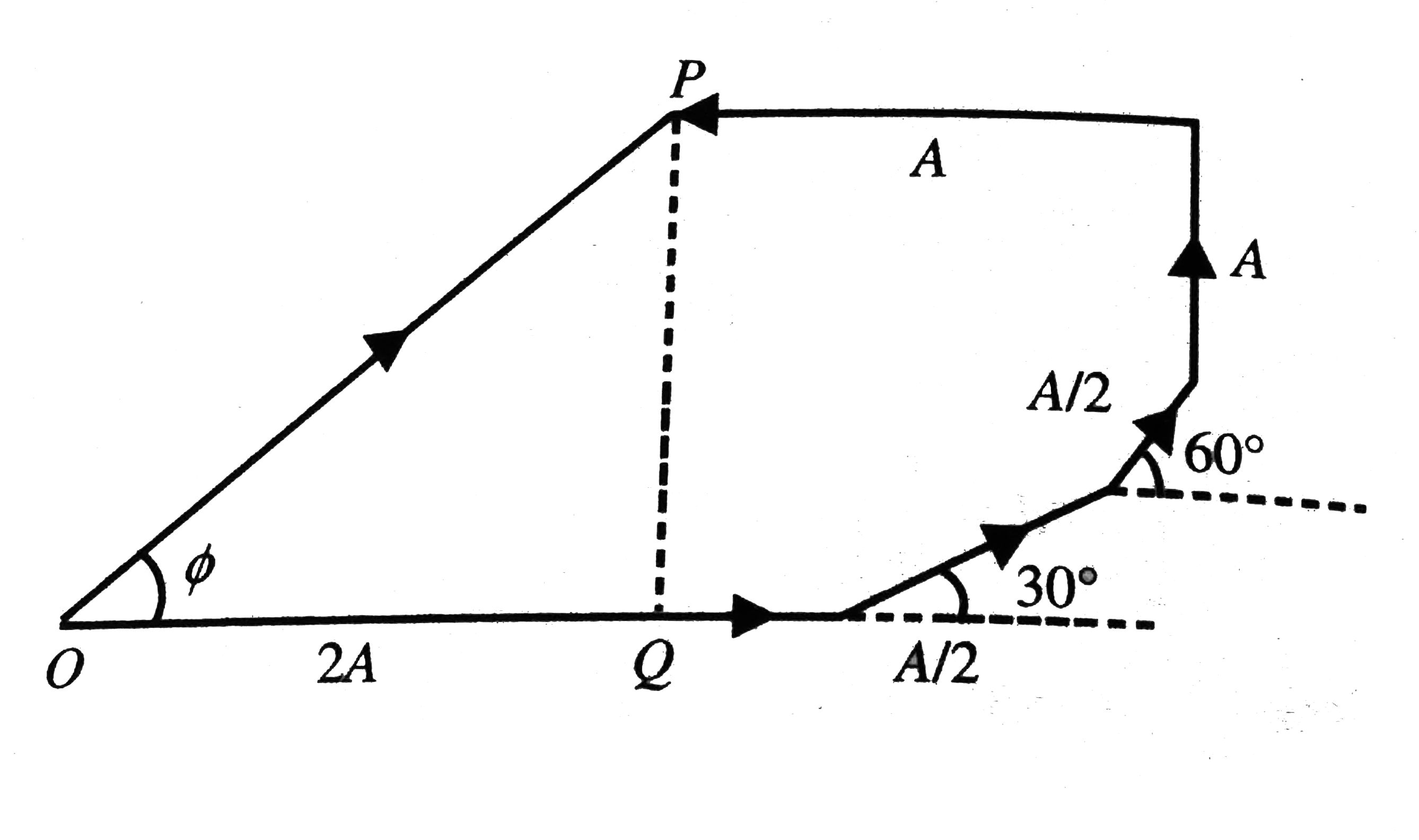Five sinusoidal waves have the same frequency 500Hz but their amplitudes are in the ratio 2:1/2:1/2:1:1 and their phase angles 0,π/6,π/3,π/2andπ, respectively . The phase angle of resultant wave obtained by the superposition of these five waves is
30∘
45∘
60∘
90∘
The correct Answer is:B
y1=2Asinωt
y2=A2sin(ωt+π6)
y3=A2sin(ωt+π3)
y4=Asin(ωtπ2)
y5=Asin(ωt+π)
By phaser diagram ,
tanϕ=PQOQ=1
ϕ=45∘
Alternatively : y=2Asinωt+A2(sinωcos30∘+cosωtsin30∘)+A2(sinωtcos60∘+cosωtsin60∘)+Acosωt−Asinωt
=A'cosϕsinωt+A'sinϕcosωt
where A'cosϕ=[A+A4(√3+1)]
where A'sinϕ=[A+A4(√3+1)]
tanϕ=1
ϕ=45∘

Topper's Solved these Questions
- BOOK - CENGAGE PHYSICSCHAPTER - SUPERPOSITION AND STANDING WAVESEXERCISE - Multiple26videos
SUPERPOSITION AND STANDING WAVES
- BOOK - CENGAGE PHYSICSCHAPTER - SUPERPOSITION AND STANDING WAVESEXERCISE - Assertion - Reasoning6videos
SUPERPOSITION AND STANDING WAVES
- BOOK - CENGAGE PHYSICSCHAPTER - SUPERPOSITION AND STANDING WAVESEXERCISE - Subjective24videos
SUPERPOSITION AND STANDING WAVES
- BOOK - CENGAGE PHYSICSCHAPTER - SOUND WAVES AND DOPPLER EFFECTEXERCISE - Integer16videos
SOUND WAVES AND DOPPLER EFFECT
- BOOK - CENGAGE PHYSICSCHAPTER - THERMODYNAMICSEXERCISE - 241videos
THERMODYNAMICS
Similar Questions
Two sinusoidal waves y1,(x,t)andy2(x,t) have the same wavelength and travel together in the same direction along a string. Their amplitudes are ym1= 4.0 mm and ym2=3.0mm, and their phase constants are 0 and π/3 rad, respectively. What are the amplitude ym', and phase constant of the resultant wave? Write the resultant wave in the form of Eq. 16-63.
View SolutionThree component sinusoidal waves progressing in the same directions along the same path have the same period byt their amplitudes are A,A2andA3. The phases of the variation at any position x on their path at time t=0are0,−π2and−π respectively. Find the amplitude and phase of the resultant wave.
View Solution
Knowledge Check
- Question 1 - Select One
Three sinusoidal waves having same frequency have amplitudes in the ratio 6:3:2 and their phases are 0,π2,π . If 6a be the amplitude of the first wave , then which of the following is not correct
Athe amplitude of the resultant wave of the three waves is 5aBphase of resultant wave is tan−1(34)Cthe amplitude of resultant wave is 5a/6Dthe frequency of the resultant wave will be that of given wave - Question 2 - Select One or More
Three simple harmonic waves , identical in frequency n and amplitude A moving in the same direction are superimposed in air in such a way , that the first , second and the third wave have the phase angles ϕ,ϕ+(π/2)and(ϕ+π), respectively at a given point P in the superposition
Then as the waves progress , the superposition will result inAa periodic , non - simple harmonic wave of amplitude 3ABa stationary simple harmonic wave of amplitude 3ACa simple harmonic progressive wave of amplitude ADthe velocity of the superposed resultant wave will be the same as the velocity of each wave - Question 3 - Select One
Two waves of same amplitude a and frequency v and having a phase difference of π/2 radian, are superposed. The amplitude of resultant wave is
A2aBaCa√2D√2a
Two waves have the same frequency . The first has intensity I0. The second has intensity 4I0 and lags behind the first in phase by π/2. When they meet , find the resultant intensity , and the phase relationship of the resultant wave with the first wave .
View SolutionTwo sinusoidal waves of the same frequency travel in the same direction along a string. If A1=m3.0cm,A2=4.0cm,ϕ1=0, and ϕ2=π/2rad, what is the amplitude of the resultant wave ?
View SolutionThe resultant amplitude, when two waves of two waves of same frequency but with amplitudes a1 and a2 superimpose at phase difference of π/2 will be :-
View SolutionA sinusoidal wave travelling in the same direction have amplitudes of 3 cm and 4 cm and difference in phase by π/2. The resultant amplitude of the superimposed wave is
View SolutionIf the phase difference between the two wave is 2π during superposition, then the resultant amplitude is
View Solution

